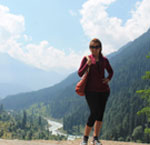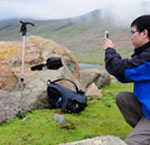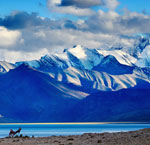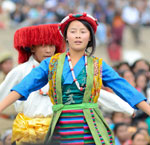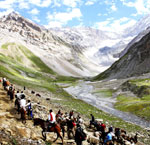Kashmir
Bangus Valley
The term Bangus is derived from from Sanskrit word Van (Forest) and gus (grass). Bangus Valley is undoubtedly a breath-taking valley The Valley is located in the Kupwara district in North Kashmir. Lying at an altitude of 10000 feet, Bangus is located about 150 kilometres from Srinagar. It lies to the west of Handwara along the Mawri River within the Handwara sub district, close to the Line of Control between India and Pakistan. The valley is spread over an area of 300 Sq. km and is circumscribed by the Shamsbery mountain range and the Leepa Valley. Chowkibal mountains fall on its northern side whereas Qazinag and Shamsbery mountains on the western side.Apart from these other hills also which also surround the vale include, Meeldar, Nastichavan and Yaddil etc.The valley consists of Bod Bangus, the principal valley and Lokut Bangus, comparatively smaller one.
Bod Bangus consists of a linear elliptical bowl aligned along the east–west axis and is circumscribed by Rajwar and Mawar in the east, Shamasbury and Dajlungun Mountains in the west and Chowkibal and Karnah Guli in the north and Kazinag Range in the south.Lokut Bangus lies on the north-eastern side of the main valley. Bidrun Top, which is a favourite destination of trekkers, is one kilometre long steep trekking from Behak area. Albeit, the valley is not widely explored yet, work is in progress to incorporate it in the tourist map of Kashmir. Lying within the Trans-Himalayan region, Bangus Valley is blessed with a unique ecological area which comprises mountains, grasslands and Taiga or Coniferous forest.
This virgin valley is replete with vegetation, flowers and forests. It has been proposed to be developed as a Himalayan Biosphere valley by INTACH. Numerous small streams along with almost 14 tributaries traverse the valley including the Roshan Kul, Tillwan Kul and Douda Kul. These freshwater oligotrophic bodies act as a source of drinking and irrigation including the source for groundwater.
The water of these streams form one of the headwaters of the Kamil River which in turn joins the Lolab stream, thus forming the Pohru River. The Kazinag spring is said to be the source of the various springs and streams in Bungus. The Dodkol has sweet and cold water. It emerges from the Dudi hill and merges with the Tilwan Kol at the Baddi Behek meadow. Roshan Kol, Satkol Nag, and its seven streams, are some other streams and lakes of the valley. The large pasturelands of the area produce the finest grass in the state. Bungus has more than a hundred meadows.
A little more than half of these are on top of plateaus while the rest are in the plains. The meadows have a great cushioned surface owing to its soft grass. The grass has a tremendous nutritional and medicinal value for the cattle.
The green gold of the place includes Blue Pine (Pinus Wallichiana), Chir Pine (Pinus Roxburghii), Himalayan cedar (Cedrus deodara), Himalayan Spruce (Picea Smithiana) and many other species.
The valley is blessed with a variety of flora and fauna. Apart from medicinal plants and fish,it is abode to almost 50 species of animals and about 10 species of birds. The animal species include the snow leopard, musk deer, antelope, brown bear, black bear, red fox and monkeys.
The prominent resident birds include tragopan, pheasants, monal pheasant, sparrow, crow, eagle, Himalayan Snowcock, Common Quail, Snow Partridge, sntakeow pigeon, common cuckoo, stork, black partridge, bush quail and wild fowl. Migratory birds can also be found here. The endemism of the valley is very high, so great care must be taken to save it from pollution and other harmful activities which can lead to habitat loss. Bangus Valley has attractions like the grasslands of Meeldar, Nastichavan, Yaddil etc. With its meadows, mountains, and streams, Bangus is truly a mesmerizing location, bound to enchant every wanderer with its charm. It is a perfect place for people who want to explore the unexplored and the offbeat.
If you want to trek here, you need to send an application in advance to the District Magistrate in Kupwara along with two photographs and a copy of ID proof.
How to Reach Bungus Valley:
Bungus can be approached from Srinagar through two routes. One is through Handwara through Satkoji and the other through Chowkibal, through Malasari. Transport is not readily available as the road is not in a good condition. From the Manzgam-Chowkibal road, it takes almost 6-8 hours to reach Bangus valley from the summer capital of Kashmir while includes an average of 2 hours of walking from Chowkibal to Bangus by foot. The place is yet to be brought on the tourist map of Kashmir and hence you may have a difficult time while reaching there, but the place is worth all the trouble.
All the approach roads to Bangus provide an ample opportunity for those in search of adventure.
By Air:
The nearest airport is Sheikh Ul Alam international airport in Srinagar located at a distance of around 90 km from Kupwara.
By Train:
The nearest railway station is at Baramulla for Kupwara, located 64km away.
Jammu Tawi, Udhampur and Katra are other options. From Baramulla railway station it takes almost 2 hours and 15 minutes by cab or bus.
By Road:
One can reach Srinagar via Road taking NH1, NH44 highway from other parts of India.
Local cabs and taxis regularly ply from Srinagar cab stands to the valley.
Best Time to Visit the Valley:
Every season brings out different shades and colours to the valley and each season is extremely breath-taking. However, the lush greenery is at its peak during the months of April to September. From December to February, Bangus valley receives heavy snowfall during winter due to which roads might be inaccessible.
Accommodation in Bangus
You can find various lodges and guest houses in and around the valley. A well maintained JKTDC guest house is also located in Reshwari. Stay houses can also be found near the district of Kupwara.
Temperature of Bangus Valley:
Max 29.5 °C to Min-1.9 °C. The months of April to September are the best to visit this place since Bangus valley temperature can reach -3 to -4 degrees during the winter and receives moderate to heavy snowfall every year.
CIN : U63040DL2008PTC177736 Government of India
Reg No : Reg/2019/DT/42/l-2 Government of J&K Tourism

